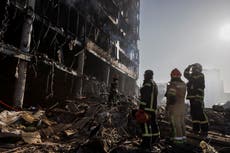What are white phosphorus bombs? All we know about incendiary weapons Russia accused of using in Ukraine
UKraine has accused Russia of using the weapons on a number of occasions, the latest in the eastern city of Bakhmut
Ukraine has accused Russia of attacking the besieged eastern city of Bakhmut with phosphorus munitions.
Drone footage released by the UKrainian military, shows parts of the city – the scene of some of the bloodiest fighting of the war – ablaze as what is alleged to be white phosphorus rains down. While white phosphorus weapons are not banned in their entirety, but their use in civilian areas is considered a war crime.
Writing on Twitter, Ukraine's defence ministry said the phosphorus attack targeted "unoccupied areas of Bakhmut with incendiary ammunition" – although it is unclear exactly when the alleged attack took place.
Moscow has been accused of using white phosphorus several times since the launch its invasion last year, including during the siege of Mariupol at the beginning of the war.
Ukrainian president Volodymyr Zelensky alleged at a summit of Nato leaders in Brussels near the start of the invasion that white phosphorus munitions had already been fired on civilians in his country’s cities.
“This morning, by the way, phosphorus bombs were used. Russian phosphorus bombs. Adults were killed again and children were killed again,” he said.
Moscow has never publicly admitted to using white phosphorous, and last year Kremlin Press Secretary Dmitry Peskov insisted "Russia has never violated international conventions" after Mr Zelensky’s remarks.
Cluster munitions are also alleged to have been fired on Ukrainian targets since the war began on 24 February while the UK’s Ministry of Defence has said that the Kremlin itself has admitted to using thermobaric rockets.
White phosphorus is a yellowish or colourless translucent substance, wax-like in texture and smelling faintly of garlic, which ignites immediately on contact with oxygen in the air, creating a bright plume of smoke.
It cannot be put out with water and burns at up to 1,300C.
The acid is commonly used in warfare to create smoke screens to conceal troop movements, to illuminate the battlefield at night or to mark targets and, because of these practical applications and the fact that it is not explicitly intended to target the body’s life systems, is not currently recognised as a chemical weapon under the 1993 Chemical Weapons Convention.
However, it can certainly be used as an incendiary weapon to maim, poison or kill indiscriminately and is known to cause instant scarring of the lungs, heart, liver and kidneys and to be capable of burning through muscle to the bone, often causing severe second and third-degree burns that typically require skin grafts.
“Incendiary weapons cause devastating burns, and in far worse ways than any of the standard scald or fire burns,” Dr Rola Hallam, a physician who treated victims of chemical warfare in Syria, is quoted as saying in a report by Human Rights Watch. “They can burn through everything. If they can burn through metal, what hope does human flesh have?”
Protocol III of the 1980 Convention on Conventional Weapons does explicitly prohibit the use of white phosphorus as a weapon against civilian populations, drawing a distinction between combatants and non-combatants, which means that the protocol is only breached if the latter group is fired upon.
Article 35 of Protocol I of the Geneva Conventions meanwhile rules that any weapon that causes “superfluous or unnecessary suffering” is outlawed, which could be applied to the indiscriminate firing of white phosphorus and potentially constitute a war crime.
“This is part of the horror of war,” lamented RAND Corporation researcher and Army veteran David Johnson in conversation with Insider recently. “These weapons were developed for military purpose. And, quite frankly, they’re going to be used.”
White phosphorus was deployed in both the First World War and Second World War and colloquially known as “WP” or “Willy Pete”.
Its legacy can still be felt: in August 2017, a woman passing the banks of the River Elbe near Hamburg plucked what she believed to be a nugget of amber from the wet sand and tucked it into her coat pocket, only for it to catch alight, the explosive revealing itself and the pedestrian only narrowly escaping serious injury.
Join our commenting forum
Join thought-provoking conversations, follow other Independent readers and see their replies
Comments





Bookmark popover
Removed from bookmarks